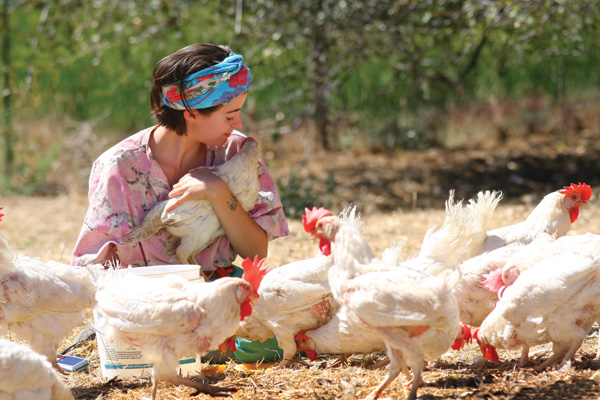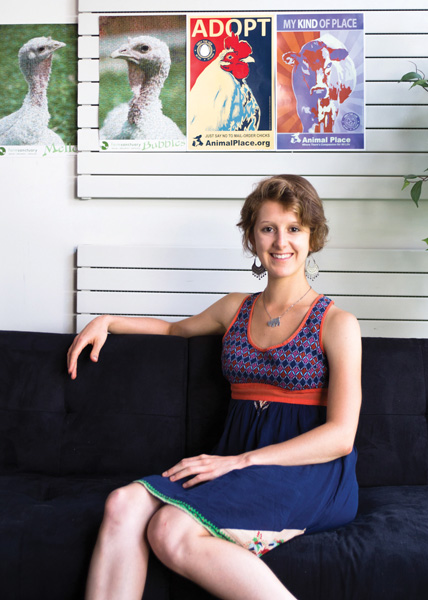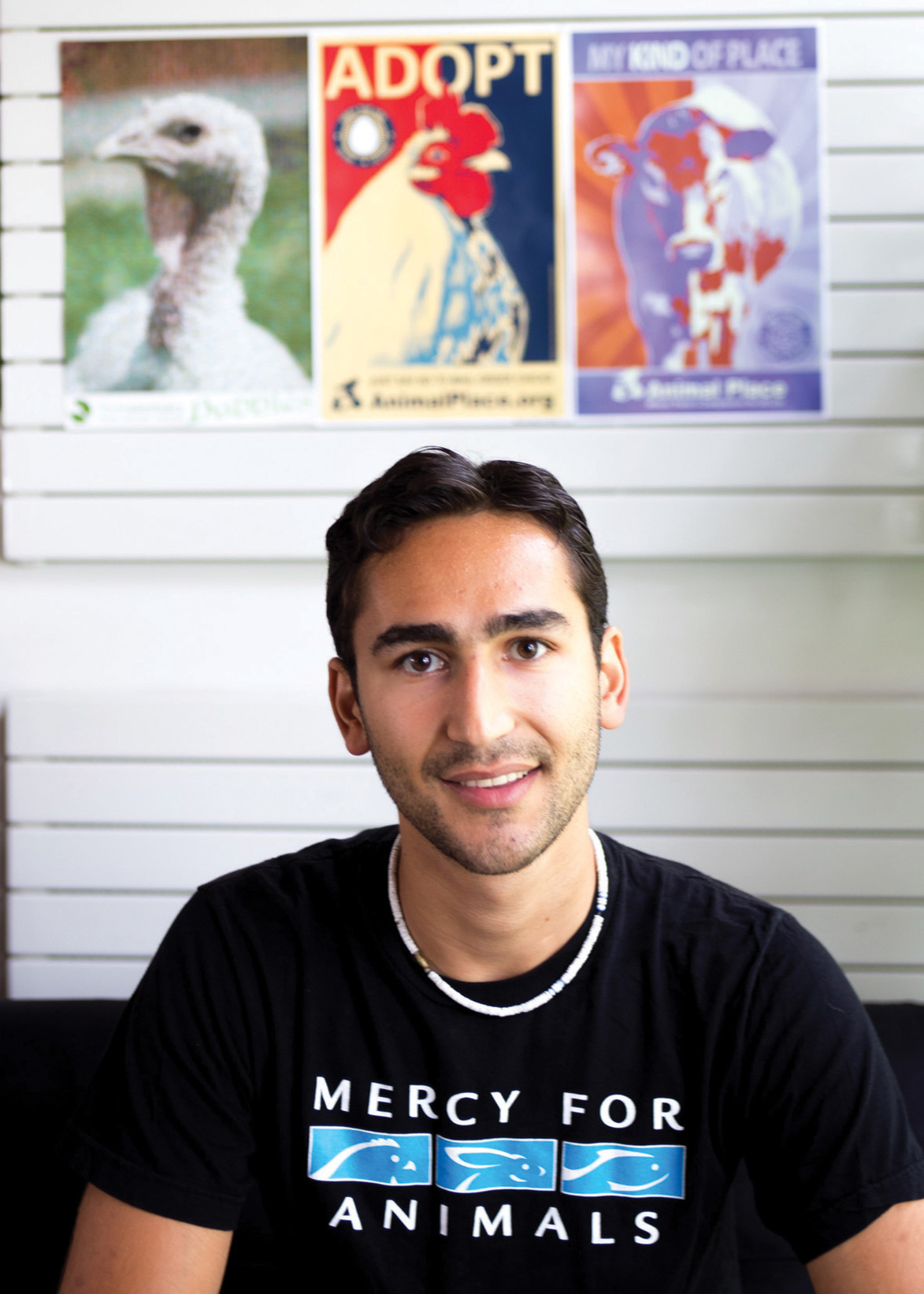Vegetarianism at Vassar … and Beyond

A generation ago, many Americans considered vegetarianism a fringe movement associated with the counterculture of the 1960s—“hippie food.” But in 2011, a survey done by the Vegetarian Resource Group (VRG) found that five percent of American adults “never eat meat, fish, seafood, or poultry.” Of that five percent, half identified as vegan, meaning they refrain from eating eggs or dairy products, as well. In addition, many vegans do not eat honey and do not use animal products such as silk, leather, or wool.
Institutions are also beginning to embrace this shift. Based on data from the Humane Society of the United States, more than 3,500 U.S. companies and schools—including Vassar—encourage participation in Meatless Mondays. According to VRG, people generally cite several reasons for becoming vegetarian, including “health, ecological and religious concerns, dislike of meat, compassion for animals, belief in nonviolence, and economics.”
The health benefits of vegetarianism have been well documented. With the exception of nuts and seeds, as well as avocados and olives, most plant foods are low in fat. A study on obesity done by the Journal of the Academy of Nutrition and Dietetics found that the obesity rate for meat eaters was 33.3 percent; for vegans, it was 9.4 percent. In addition, the Adventist Health Study-2 discovered that vegans have a 68 percent lower rate of diabetes than nonvegetarians. Several studies reviewed by the Annals of Nutrition & Metabolism indicate that death rates from heart disease are 29 percent lower for vegetarians than nonvegetarians, while cancer rates are 18 percent lower.
However, many people decide to become vegetarian because of their concern about the treatment of animals. According to the Humane Society, of the approximately 11 billion livestock animals killed annually in the United States, 86 percent are chickens and turkeys raised on factory farms. A report by the organization revealed the conditions on such farms. “Birds raised for meat are confined by the tens of thousands in grower houses” without natural light or ventilation. Egg-laying hens are generally confined in small wire “battery cages” stacked several tiers high, in which they’re given “less than a letter-sized sheet of paper” of living space.
Pigs and cows don’t fare much better on factory farms, according to the animal welfare organization. It reports, for example, that “Pigs raised for meat undergo mutilations—including castration and tail docking—without pain relief.” When pigs and cattle arrive at slaughterhouses, they undergo a slaughtering procedure similar to chickens.
In “Veganism for Omnivores,” a lecture at Vassar on “humanely” raised farm animals this past fall, James McWilliams, professor of history at Texas State University in San Marcos, noted that free-range animals face similar fates. Farmers who raise them cannot allow their herds to become too large, because overgrazing would ruin their pastures. Therefore, excess calves, for example, may be sold to feedlots “to be raised under conventional circumstances.”

McWilliams also noted that, although sources vary on the exact figure, “Animal agriculture produces 18 to 50 percent of greenhouse gases” in the world. Indeed, concern for the environmental effects of eating meat has convinced many to take up vegetarianism.
The Humane Society also reported on slaughterhouse procedures. Chickens and turkeys are shackled and hung upside down by their legs, and “their heads pass through an electrified water bath before their throats are cut, usually by machine.”
Jill Schneiderman, professor of earth science and geography, describes herself as “largely vegetarian for reasons related to the environmental costs of meat production and animal ethics.” She says she tries to help students see that concentrated animal feeding operations (CAFOs, or factory farms) are “not only inhumane, they are big environmental polluters.”
According to Humane Society figures, CAFOs produce more than 500 million tons of manure in this country every year. Pathogens, including those from manure, and nitrates from CAFO waste ultimately impact groundwater and human drinking water, Schneiderman says, adding, “Ammonia from CAFOs causes algae to grow in surface waters and crowd out other things that have been living there.”
There is a strong contingent of vegetarian and vegan students on campus, and most cite ethical reasons for changing their diets. Many are members of the Vassar Animal Rights Coalition (VARC), an organization that “works to better the lives of nonhuman animals through a diverse range of projects.” Members aim to “encourage awareness in the Vassar community about the impacts of consumer choices and behaviors on the lives of animals, namely in relation to food, clothing, and animal testing.”
During his freshman year, VARC member (and treasurer) Alan Darer ’14 decided to become vegan after attending the organization’s screening of Fowl Play, a documentary about the abuses in the egg industry. “I decided these were practices I didn’t want to support,” he recalls.
Fellow member Katie Maguire ’16 changed her eating habits after reading Jonathan Safran Foer’s book Eating Animals, an unflinching look at factory farming. Maguire—who is currently co-president of VARC, along with Alessandra Seiter ’16—says she chose veganism over vegetarianism because she “realized that the dairy and egg industries were just as problematic as the meat industries” in the way they treat animals.

VARC created its Veggie Buddy initiative to help students transition to a vegan diet. The program pairs those who wish to become vegan with a VARC member who is available 24/7 to answer questions for one month. To ease the transition to a vegan diet and to raise awareness about animal rights, Seiter created VARC’s site (vassaranimalrights.wordpress.com), which provides a comprehensive list of resources on vegan topics, ranging from animal welfare to nutrition.
Seiter also prepares the food for all VARC events, which this winter included a vegan wine-and-cheese tasting that attracted over 200 people. She develops her own recipes for her catering, and one of her specialties is vegan cheese made from cashews or almonds. Seiter started Farmers Market Vegan, a blog that has allowed her to share such recipes with others, as well as to discuss the “social justice issues related to veganism.”
For the past 10 years, VARC has been working with Campus Dining staff to increase vegan food options at Vassar. ACDC offers a rice dish and a bean dish every day, along with at least one vegan entrée—such as hummus, sesame noodles, or chili—at each meal. Most vegetables are locally sourced from the Hudson Valley, and all are cooked with vegetable oil. Students can even make their own meal at a special stir-fry area, from “an array of vegetables, oils, pasta, tofu, rice, and sauces,” says Maureen King, senior director of campus dining. The Retreat offers a selection of vegan “meats” and cheeses, black bean burgers, and vegan pizza.
VARC members work with ACDC staff to host Meatless Mondays, on which ACDC features a special vegan entrée. Darer says, “About 25 percent of the people on the meal plan have signed up.” Once a month, VARC and Campus Dining collaborate on a special all-vegan buffet, for which one side of ACDC is reserved. All of their work has paid off. A recent survey done by peta2 (an offshoot of People for the Ethical Treatment of Animals that does outreach to youth) gave Vassar an “A” for vegan-friendly campus dining.
VARC members are taking their activism beyond campus, as well. Last summer, Rockwell “Rocky” Schwartz ’15 interned at Animal Place, a farm animal sanctuary located in Grass Valley, CA, where she and her colleagues rescued 3,000 hens from an egg-laying facility. She said: “The chickens are routinely gassed when they’re two years old, because the eggs they lay become too soft to be shipped. The farm planned to gas about 50,000 [hens], and while we were able to rescue 3,000 of them, it was emotionally difficult to know 47,000 others were dying.”
For two days, Schwartz and her colleagues removed hens from battery cages, and bathed them in powder to remove lice. Once the hens recovered, 2,000 of them were sent to shelters or adoptive homes in California, while the remaining 1,000 were sent to shelters or homes on the East Coast. After Schwartz learned that commercial aircraft are not allowed to transport live chickens, Animal Place secured funding from an anonymous donor and arranged for a charter plane to fly them to the East Coast. The hens arrived in New York City on September 5, 2013, generating coverage in the New York Times, New York Daily News, and USA Today.
Darer interned at the New York office of Mercy for Animals, “a nonprofit animal rights organization focused on promoting a vegetarian diet,” where he participated in a special “pay-per-view” outreach program. Along with his colleagues, he offered passersby $1.00 to watch excerpts of Farm to Fridge, a documentary about factory farming. “People are shocked and horrified to find that farm animals suffer the outrageous abuses that they do,” says Darer. “Some people cry. Some can’t finish watching the video.”
Maguire and Seiter interned at the Washington, DC–based Compassion Over Killing, an organization “working to end animal abuse by focusing on cruelty to animals in agriculture, and promoting vegetarian eating.” In addition to engaging in outreach activities to educate the public about animal rights and veganism, Maguire and Seiter helped organize DC VegFest.
The event, which took place in September 2013, featured speakers on vegetarian-related issues, as well as exhibitors of vegetarian products. Ultimately, more than 10,000 people attended the festival.
These student activists are now surveying their post-graduation options. Darer will begin a full-time job with Mercy for Animals in May, and Maguire and Schwartz are both considering careers in animal advocacy. Seiter hopes to obtain a Watson Fellowship, which supports a year of independent study, to examine “plant-based communities around the globe, to see if they’re more egalitarian than meat-based societies,” before going to work in animal advocacy.
DID YOU KNOW?
According to the Humane Society of the United States, Meatless Mondays date back to World War I. The federal government rationed meat—thus encouraging people to eat less of it—so it could be sent to soldiers overseas. The tradition was revived during World War II. Marketing guru Sid Lerner, in conjunction with the Johns Hopkins Bloomberg School of Public Health, later resuscitated the effort to fight the “war on obesity” in 2003.
—Sara Sezun ’88
Sara Sezun is a writer and playwright living in Boston. She has been vegan for the past 20 years.
